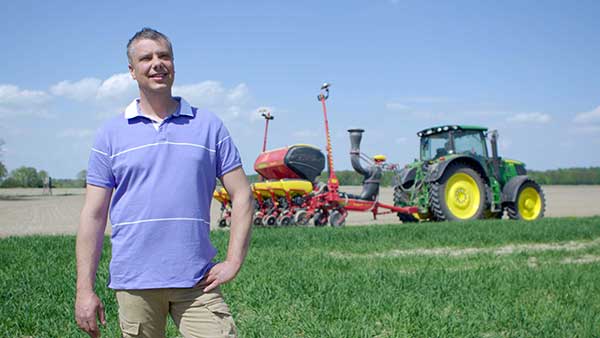Farmer: Arkadiusz Gobiowski
Location: Lipiany, North-west Poland
Farm size: 300 hectares
Crops: Maize, sugar beets
Tempo model: Väderstad Tempo T
I have been running my farm since 2005. Before that the farm belonged to my parents, but already in 1998 I worked with my father. Now the farm has 300 hectares. We own 250 hectares, and the area of 50 hectares is leased by us.
Now we use Tempo to plant beetroot and corn, though our initial intention was to buy the machine in order to use it for planting oil rape. Until recently we used to grow oil rape and triticale, but because of the highest risk involved with these crops and their low profitability (due to high costs) we decided to give them up. For two years in a row the oil rape yields were only about 2 tonnes per hectare, though we carried out all agricultural treatments. We are not pampered by the climate here. The poor potential of these crops results also from low prices that do not bode well for the nearest future.
We have had our Tempo for two seasons. In the previous one we used the planter to sow 400 hectares, part of the area as a service provider. We plant about 100 hectares of corn, and we have increased the area sown in beetroot to 60 hectares permissible in the present crop area limitation programme. This year we have 60 hectares of wheat, then there is milk thistle, and on top of that we are experimenting with cannabis sativa.
Tillage system
We use reduced tillage on half of the fields in our farm, while the other half is ploughed. Because of large numbers of wild animals (mainly boar) in our area we cannot use reduced tillage in every part of our farm. The reduced tillage system is really good, the results were satisfying, but afterwards the crops got heavily damaged. Because of this we would like to plough all the fields in our farm, but we do not always find enough time for it. When time is short, we use no-plough tillage. The whole area of the ploughed fields is tilled with Tempo, but I want to give the strip till a try.
My reasons for appreciating Tempo?
I cannot say that there is one particular characteristics that makes me value this machine so highly. What makes the planter unique is a whole set of advantages. This uniqueness results from the working speed and the sowing precision, which means both maintenance of the working depth and the in-row precision. We use the navigation system of John Deere, which limits the working speed to about 12 km/h when beetroot is sown. Then the navigation system just stops being reliably precise, but the planter itself works perfectly, the precision being 98–99 per cent. When you sow beetroot, a very high precision of planting is required, and we had good results, but on sloping fields the navigation system lost some precision, which did matter, as the precision is essential when you use a beetroot combine. When beetroot rows overlap, the combine cuts the beetroots out in these overlaps. We planted corn at the speed of 15 km/h. We worked under a serious pressure because of time and weather, so we planted as many as 50 hectares of corn a day.
I am very satisfied with my Tempo. In the first season we sowed 400 hectares without any fault.
Fertilizer application
When we grow beetroot, we use our Tempo to apply fertilizer. The precision was really impressive, everything worked just fine. We saved a huge amount of fertilizer, as much as 300 kg per hectare. The results were incredibly impressive and the costs trifling, because we spent about 450 zlotys per hectare. Before our investment in a Tempo planter we usually had to spend about 1,000 zlotys per hectare, so we do save a lot. The beetroot yield was 80 tonnes per hectare. I am very satisfied.
Soil quality
The soils in the farm are mainly of classes 2 and 5. The planter gives satisfying results on mosaic soils, all you need is just appropriate settings.
Efficiency
We face a huge problem of a serious shortage of workforce in our region. But for the efficiency of the machines we use we would not be able to till such a large area. We suffered from droughts in 2015 and 2016 r., and from a flood in 2017. Our losses exceeded 200,000 zlotys.

Farmer: Marcin Walczak
Company: Rolwax
Location: Przydroe Mae, South-western Poland
Farm size: 600 hectares
Tempo model: Väderstad Tempo F

Farmer: Grzegorz Urbanek
Location: Podkarpacie region, south-eastern Poland.
Farm size: 350 hectares
Crops: Maize
Tempo model: Väderstad Tempo T
